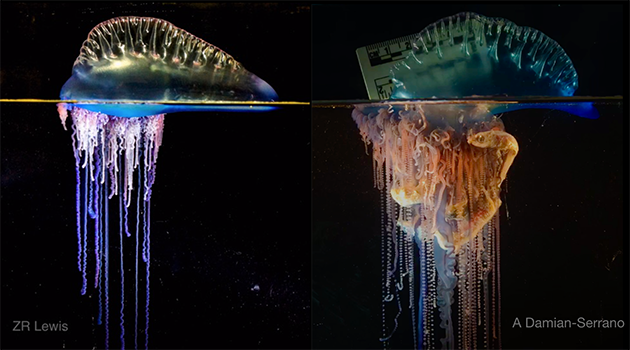Posted in:
When is a Jellyfish Not a Jellyfish?

A team of scientists from Yale University traveled to BIOS in May to study the Portuguese man o’ war, a frequent visitor to the waters around Bermuda during spring and early summer.
With their blue and purple bladders floating on the water’s surface, the organisms are said to resemble an 18th century Portuguese armed sailing ship at full sail, giving them their unique name. Below these gas bladders are curtains of venomous tentacles that extend an average of 30 feet (9 meters) below, causing many to mistake man o’ war for jellyfish. However, while the man o’ war is related to jellyfish and corals, it’s actually a colony of genetically identical individual organisms—called zooids—that work together to help the animal capture prey, feed, and reproduce.
Despite being commonly found floating in the open ocean, or washed up on beaches, in tropical and subtropical regions, there is much that scientists don’t know about these animals. With funding from the National Science Foundation, Casey Dunn’s lab in the Department of Ecology and Evolutionary Biology at Yale University sent three members to BIOS for a week of intensive field and laboratory investigations. Specifically, they are interested in the role that man o’ war play in oceanic food webs, how genetically diverse they are, and the physiological adaptations that allow them to survive the harsh rays of the sun for the entirety of their lives.

Alejandro Damian-Serrano, a doctoral candidate, is studying man o’ war predation. He is interested in what prey they eat, how selective they are, how they capture various prey, and how their tentacles have evolved to allow the organisms to become specialized predators.
“Siphonophores are abundant, diverse, and widespread predators in all oceans of the world yet their role in marine food webs has been long overlooked,” Damian-Serrano said. “They are an ideal system to study the evolution of prey capture tools, as they have tentacles that are exclusively used to capture prey with a wide range of shapes and sizes.”
To get a sense of the animals’ diet, he collected gut samples from man o’ wars to run through DNA tests—called metabarcoding analyses—that can identify the individual prey species that were ingested. He also conducted plankton tows from a BIOS research vessel to collect samples of local plankton species, which will be used to quantify different prey types and yield insight into how selective the man o’ war is in its prey capture. Finally, tissue samples collected from the man o’ wars are being sent to collaborators at the Scripps Institute of Oceanography, where chemical analysis will help determine what position the man o’ war occupies in the marine food web (also known as the organism’s “trophic level”).
Zack Lewis, a postdoctoral associate, is studying the genetic diversity of the Portuguese man o’ war and how it responds to ultraviolet (UV) radiation.
“Scientists have known for a long time that man o’ war are good at absorbing UV radiation at wavelengths that cause sunburn in humans, but we’re hoping to find what compound is responsible for this ability and determine whether the animal can synthesize it itself,” Lewis said. To do so, he will analyze the compounds that are in the UV-absorbing tissues and look at the genes that may play a role in producing this “sunscreen.”
Reza Bergemann, an undergraduate studying mechanical engineering at Yale, is designing a small robotic vehicle that can track man o’ war in the water for extended periods of time. By combining footage of the animal at sea with meteorological data, Bergemann hopes to contribute to a greater understanding of the life of man o’ war in the open ocean.
Dunn’s lab is associated with the Invertebrate Zoology Department at the Yale Peabody Museum of Natural History. Many of the specimens collected during the team’s research at BIOS will be subsampled for genetic research and go into the permanent collection at the museum, where they will then be available via loan to other scientists.
Tagged: